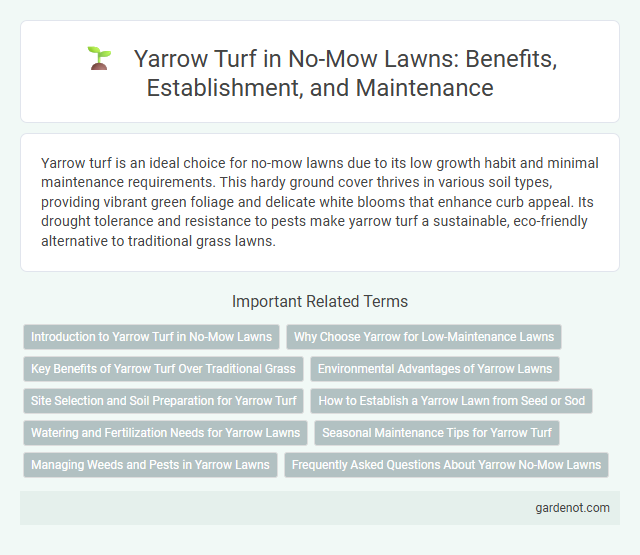Yarrow turf is an ideal choice for no-mow lawns due to its low growth habit and minimal maintenance requirements. This hardy ground cover thrives in various soil types, providing vibrant green foliage and delicate white blooms that enhance curb appeal. Its drought tolerance and resistance to pests make yarrow turf a sustainable, eco-friendly alternative to traditional grass lawns.
Introduction to Yarrow Turf in No-Mow Lawns
Yarrow turf offers a drought-tolerant, low-maintenance alternative for no-mow lawns, thriving with minimal watering and mowing requirements. Its deep root system enhances soil health while the dense, soft foliage suppresses weeds and reduces lawn care efforts. Ideal for eco-friendly landscaping, yarrow turf supports biodiversity and provides a durable, green groundcover year-round.
Why Choose Yarrow for Low-Maintenance Lawns
Yarrow turf offers exceptional drought tolerance and requires minimal mowing, making it ideal for low-maintenance lawns. Its dense growth suppresses weeds naturally, reducing the need for chemical treatments and frequent upkeep. This hardy ground cover adapts well to various soil types, ensuring a vibrant, eco-friendly lawn with minimal effort.
Key Benefits of Yarrow Turf Over Traditional Grass
Yarrow turf offers superior drought resistance and requires significantly less water than traditional grass, making it an eco-friendly choice for sustainable landscaping. Its deep root system improves soil health and reduces erosion, while its low maintenance needs eliminate frequent mowing and fertilizer applications. This hardy ground cover also supports local pollinators by producing attractive blooms, enhancing biodiversity in no-mow lawns.
Environmental Advantages of Yarrow Lawns
Yarrow lawns significantly reduce water consumption compared to traditional grass, promoting sustainable landscaping by thriving in drought-prone areas. Their deep root systems enhance soil health and prevent erosion, contributing to improved ecosystem stability. These low-maintenance lawns also support biodiversity by providing habitat and food sources for pollinators like bees and butterflies.
Site Selection and Soil Preparation for Yarrow Turf
Yarrow turf thrives best in well-drained, sandy or loamy soils with a neutral to slightly alkaline pH range of 6.0 to 8.0, making site selection crucial for optimal growth and drought resistance. Preparing the soil involves thorough clearing of existing vegetation, loosening the soil to a depth of at least 6 inches, and incorporating organic matter to improve structure and nutrient availability. Proper site and soil preparation enhance root establishment and promote a dense, low-maintenance Yarrow turf that supports biodiversity in no-mow lawns.
How to Establish a Yarrow Lawn from Seed or Sod
Establishing a Yarrow lawn from seed requires preparing well-drained soil by removing weeds and loosening the topsoil for optimal germination. Sow Yarrow seeds evenly, lightly covering them with soil and keeping the area consistently moist until seedlings emerge, typically within 10 to 14 days. For sod installation, lay Yarrow sod on a smooth, fertile surface, press firmly to eliminate air pockets, and water regularly during the first few weeks to promote root establishment and a dense, drought-tolerant lawn.
Watering and Fertilization Needs for Yarrow Lawns
Yarrow turf requires minimal watering, thriving in well-drained soil with only occasional irrigation during extended dry periods. Fertilization needs are low, as yarrow lawns benefit from light applications of balanced fertilizer in early spring to promote healthy growth without excessive lushness. This drought-tolerant plant reduces maintenance costs and conserves water resources compared to traditional grass lawns.
Seasonal Maintenance Tips for Yarrow Turf
Yarrow turf requires minimal mowing and thrives with seasonal maintenance such as light trimming in early spring to encourage dense growth and prevent weed invasion. Applying a balanced, slow-release fertilizer in late spring supports healthy foliage and vibrant blooms throughout the summer. Regularly removing dead or diseased foliage in fall helps maintain the turf's resilience and prepares it for winter dormancy.
Managing Weeds and Pests in Yarrow Lawns
Yarrow turf offers natural resistance to many common lawn pests and diseases, reducing the need for chemical interventions. Effective weed management in yarrow lawns involves regular monitoring and targeted removal of invasive species to maintain turf density and health. Incorporating organic mulches and promoting beneficial insects supports a balanced ecosystem that naturally controls weed proliferation and pest outbreaks.
Frequently Asked Questions About Yarrow No-Mow Lawns
Yarrow no-mow lawns require minimal maintenance, thriving in well-drained soils with full sun exposure and tolerating drought conditions effectively. This perennial groundcover reaches about 6 to 12 inches in height and rarely needs mowing, making it ideal for sustainable landscaping and pollinator-friendly gardens. Common concerns include its ability to suppress weeds naturally and minimal irrigation needs, which contribute to its eco-friendly appeal.
Yarrow turf Infographic

 gardenot.com
gardenot.com